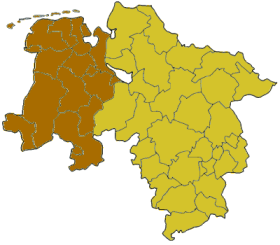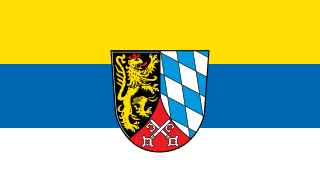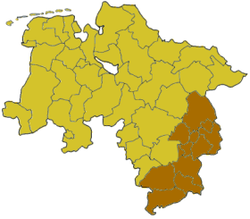
Lower Saxony is a German state in northwestern Germany. It is the second-largest state by land area, with 47,614 km2 (18,384 sq mi), and fourth-largest in population among the 16 Länder federated as the Federal Republic of Germany. In rural areas, Northern Low Saxon and Saterland Frisian are still spoken, albeit in declining numbers.

A Regierungsbezirk means "governmental district" and is a type of administrative division in Germany. Currently, four of sixteen Bundesländer are split into Regierungsbezirke. Beneath these are rural and urban districts.

Swabia is one of the seven administrative regions of Bavaria, Germany. It consists of ten districts and 340 municipalities.

The Regierungsbezirk Weser-Ems was the most westerly of the four administrative regions of Lower Saxony, Germany, bordering on the Dutch provinces of Groningen, Drenthe and Overijssel. It was established in 1978 by merging the former regions Osnabrück, Aurich, and Oldenburg. It was formally dissolved by the end of 2004 along with the other Regierungsbezirke of Lower Saxony as part of an effort to optimize the administrative system of the state.
Nienburg is a district (Landkreis) in Lower Saxony, Germany. It is bounded by the districts of Diepholz, Verden, Heidekreis, Hanover and Schaumburg, and by the state of North Rhine-Westphalia.

Lower Franconia is one of seven districts of Bavaria, Germany. The districts of Lower, Middle and Upper Franconia make up the region of Franconia. It consists of nine districts and 308 municipalities.

Upper Franconia is a Regierungsbezirk of the state of Bavaria, southern Germany. It forms part of the historically significant region of Franconia, the others being Middle Franconia and Lower Franconia, which are all now part of the German Federal State of Bayern (Bavaria).

Middle Franconia is one of the three administrative regions of Franconia, Germany, in the west of Bavaria bordering the state of Baden-Württemberg. The administrative seat is Ansbach; the most populous and largest city is Nuremberg.

Arnsberg is one of the five Regierungsbezirke of North Rhine-Westphalia, Germany, located in the west-central part of the country. It covers the Sauerland hills as well as the east part of the Ruhr area.

Detmold is one of the five Regierungsbezirke of North Rhine-Westphalia, Germany, located in the north-east of the state. It is congruent with region of Ostwestfalen-Lippe.

Düsseldorf is one of the five Regierungsbezirke of North Rhine-Westphalia, Germany, located in the north-west of the country. It covers the western part of the Ruhr Area, as well as the Niederrheinische Tiefebene, the lower Rhine area. It is the most populated of all German administrative areas of the kind. It is the only area in Germany where the traditional dialects are Low Franconian, rather than Low German or High German.

Münster is one of the five Regierungsbezirke of North Rhine-Westphalia, Germany, located in the north of the state, and named after the capital city of Münster. It includes the area which in medieval times was known as the Dreingau.

Lower Bavaria is one of the seven administrative regions of Bavaria, Germany, located in the east of the state. It consists of nine districts and 258 municipalities.

The Upper Palatinate is an administrative district in the east of Bavaria, Germany. It consists of seven districts and 226 municipalities, including three cities.

Lüneburg was one of the four Regierungsbezirke of Lower Saxony, Germany, located in the north of the federal state between the three cities Bremen, Hamburg and Hanover.

The Province of Hanover was a province of the Kingdom of Prussia and the Free State of Prussia from 1868 to 1946.
The Landesliga Weser-Ems, called the Bezirksoberliga Weser-Ems from 1979 to 1994 and 2006 to 2010, is the sixth tier of the German football league system and the second highest league in the German state of Lower Saxony (German:Niedersachsen). It covers the region of the now defunct Regierungsbezirk Weser-Ems.
The Landesliga Hannover, called the Bezirksoberliga Hannover from 1979 to 1994 and 2006 to 2010, is the sixth tier of the German football league system and the second highest league in the German state of Lower Saxony. It covers the region of the now defunct Regierungsbezirk Hanover.
The Landesliga Braunschweig, called the Bezirksoberliga Braunschweig from 1979 to 1994 and 2006 to 2010, is the sixth tier of the German football league system and the second highest league in the German state of Lower Saxony. It covers the region of the now defunct Regierungsbezirk Braunschweig.
The Landesliga Lüneburg, called the Bezirksoberliga Lüneburg from 1979 to 1994 and 2006 to 2010, is the sixth tier of the German football league system and the second highest league in the German state of Lower Saxony (German:Niedersachsen). It covers the region of the now defunct Regierungsbezirk Lüneburg.















